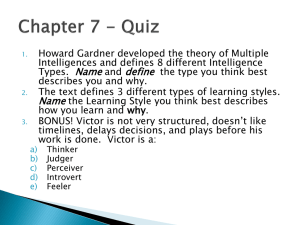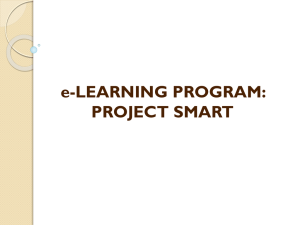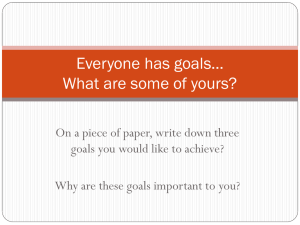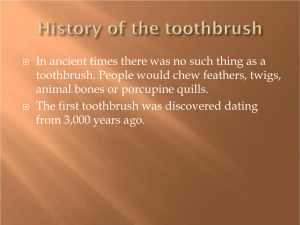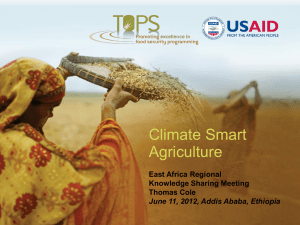LEARNING HOW TO THINK AND TO LEARN
advertisement
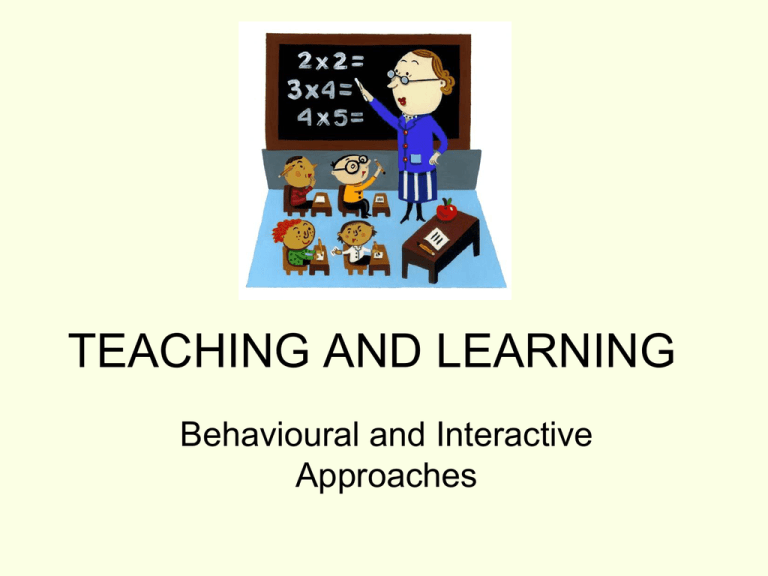
TEACHING AND LEARNING Behavioural and Interactive Approaches By the end of the day you should be able to: • Use behavioural and interactive approaches in your teaching • Use SMART and SCRUFFY targets Approaches to Teaching and Learning Behavioural Approaches Learning is explicit Operant Conditioning The response following the behaviour makes that behaviour likely to be repeated Behavioural approach to learning • • • • • • • • Observable behaviour Change the behaviour Positive reinforcement Negative reinforcement (removal of a reward) Punishment Extinction Measurement Individualised learning Tangible rewards How do you use behavioural approaches in your life? Behavioural Teaching • Skills-based approach • Task/ functional analysis • Chaining (backwards and forwards) • Prompting • Fading • Shaping • Generalisation Precision Teaching Short energetic practice sessions Collect data to show progress Support from coach Errorless Learning Bryony learned to read using errorless learning She was taught using flashcards Her mum used flashcards with the word on one side and picture on the other. If Bryony didn’t know the word then she flipped over to let her name the picture TARGET SETTING SMART targets • • • • • Specific Measurable Achievable Realistic Time related We can use SMART targets in education I can statements I can walk away from people when I am feeling angry SMART target • I can count 1-5 when pulling each object towards me. I will count like this every day for the next 6 weeks. SMART target • John will take the spoon from an adult once it has been loaded with food and put it in his mouth. He will be prompted by the adult open hand held out to hand the spoon back to the adult. He will do this for at least the first 2 spoonfuls of his first course and all but the last spoonful of his pudding. Review in July. You write a SMART target Write a SMART target for a child who is learning to drink from cup. Select a small step within this general aim suitable for a learner you know. Task Analysis • • • • • • • • • • • • • • • Take toothpaste in one hand Unscrew the top with the other Put the top down Pick up the toothbrush Squeeze toothpaste onto the brush Put the toothpaste down Turn on the tap Place the brush under the tap Turn off the tap Scrub the teeth – front and back – top and bottom Turn on the tap Rinse the brush Put the brush down Replace the cap on the toothpaste Put both brush and toothpaste away You do a task analysis • Write out the steps for putting on a coat • Write out the steps for finding a favourite game on the CBeebies website Small steps learning • Forward-chaining (start at the first step) • Backward-chaining (start at the last step) Interactive Approaches Intensive Interaction Children (& adults) with PMLD need lots of that early interaction given to typical infants if they are to learn how to communicate with other people Interactive approaches are essentially about having fun! offer wonderful contexts for learning interactively How can we to get learners to think? sabotage to encourage thinking questioning the unusual predicting increasing memory asking questions learning from mistakes How can we challenge learners to think and solve problems during the routines of the day? and in lessons? Interactive approaches can help learners to generalise their skills and understanding TARGET SETTING Writing targets • SMART for products of learning eg: coat that has been put on or box full of shapes • SCRUFFY for processes eg: listening or being sociable SCRUFFY targets • • • • • • • Student-led Creative Relevant Unspecified Fun For Youngsters Strengths • What the child can do well • What the child seems to be just starting to learn • What the child likes/ what motivates him or her • How, where and with whom the child learns best Needs • • • • What the child needs right now (eg: to run about the classroom or 2 minute activities or a choice of 3 pictures or ….) What the child needs to learn next (based on what the child is beginning to learn - see strengths list) What support/ environment the child needs to learn best (Be careful to stick to the child’s needs and not the adults’ needs nor what comes next in the curriculum) SCRUFFY target • Sam will show through his responses that he likes some stimuli and dislikes others • (not ‘Sam will blink his eyes rapidly to show he dislikes lemon juice and a loud clap, 3 out of 4 times 3 days consecutively’) Name Mary Smith Key Target Routes 14 Anticipates repetitively presented stimuli Date May 2011 Anticipated fan on face Anticipate fan on hands Needed fewer repetitions 1 2 3 4 5 6 7 8 9 10 11 12 13 14 15 16 17 18 19 20 21 22 23 24 25 26 27 28 29 30 31 How do your targets /learning objectives enable your learners to: • Explore the world around them • Take control of their lives and learning • Learn from mistakes • Demonstrate their understanding • Use strategies to improve their learning • Learn from social interaction • Solve problems • Take responsibility • Negotiate their own learning • Achieve as much independence as possible? Write a SCRUFFY process target for one of your pupils


